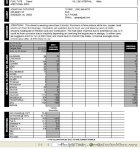USAF oil analysis
I've never done oil analysis on trucks, but I have done oil analysis on 16s and 130s for four years. The concentration of wear metals in the oil isn't what you should be concerned with. You need to keep an eye on the trend. If the ppm of any element is steadily increasing with each consecutive sample, that is normal. If the concentration of an element suddenly spikes, thats when you should be worried.
I don't understand why civilians would need oil analysis. Its really only necessary when reliability is an issue. Case in point, we sampled 16s after EVERY flight because engine reliability was crucial. An F16 has one engine. If a bearing shits out during flight, it becomes a multi million dollar lawn dart.
Jasonjc -- I'm certain that there is tech data somewhere that delineates the sample interval and trend indices's for your engine. We never tracked phosphorus or zinc, which means that they probably aren't important for these engines either. Iron looks high to me but that could be contamination. If you get bad results, the FIRST step (before panic) is a resample. For us, zinc was actually an indicator that the sample was taken improperly. We regularly dazzled the Crew Chiefs with our ability to identify whether or not they had done their job properly.
As garp stated earlier, getting an accurate sample is CRUCIAL. Sodium, zinc, and silicon are all contaminants, not wear metals.
I've never done oil analysis on trucks, but I have done oil analysis on 16s and 130s for four years. The concentration of wear metals in the oil isn't what you should be concerned with. You need to keep an eye on the trend. If the ppm of any element is steadily increasing with each consecutive sample, that is normal. If the concentration of an element suddenly spikes, thats when you should be worried.
I don't understand why civilians would need oil analysis. Its really only necessary when reliability is an issue. Case in point, we sampled 16s after EVERY flight because engine reliability was crucial. An F16 has one engine. If a bearing shits out during flight, it becomes a multi million dollar lawn dart.
Jasonjc -- I'm certain that there is tech data somewhere that delineates the sample interval and trend indices's for your engine. We never tracked phosphorus or zinc, which means that they probably aren't important for these engines either. Iron looks high to me but that could be contamination. If you get bad results, the FIRST step (before panic) is a resample. For us, zinc was actually an indicator that the sample was taken improperly. We regularly dazzled the Crew Chiefs with our ability to identify whether or not they had done their job properly.
As garp stated earlier, getting an accurate sample is CRUCIAL. Sodium, zinc, and silicon are all contaminants, not wear metals.


